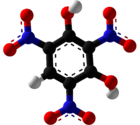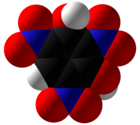Styphnic acid
 | |||
| |||
| Names | |||
|---|---|---|---|
| Preferred IUPAC name 2,4,6-Trinitrobenzene-1,3-diol | |||
| Identifiers | |||
3D model (JSmol) | |||
| ChemSpider | |||
| ECHA InfoCard | 100.001.306 | ||
PubChem CID | |||
| UNII | |||
| UN number | 0219 – Dry or wetted with < 20% water/alcohol 0394 – Wetted with >= 20% water/alcohol | ||
CompTox Dashboard (EPA) | |||
| |||
| |||
| Properties | |||
| C6H3N3O8 | |||
| Molar mass | 245.11 g/mol | ||
| Density | 1.829 g/cm3 | ||
| Melting point | 180 °C (356 °F; 453 K) | ||
| Boiling point | decomposes | ||
Except where otherwise noted, data are given for materials in their standard state (at 25 °C [77 °F], 100 kPa). | |||
Styphnic acid (from Greek stryphnos "astringent"[1]), or 2,4,6-trinitro-1,3-benzenediol, is a yellow astringent acid that forms hexagonal crystals. It is used in the manufacture of dyes, pigments, inks, medicines, and explosives such as lead styphnate. It is itself a low-sensitivity explosive, similar to picric acid, but explodes upon rapid heating.[2]
History
[edit]It was discovered in 1808 by Michel Eugène Chevreul who was researching ways of producing colorants from tropical logwoods.[3] Upon boiling Pernambuco wood extract with nitric acid he filtered crystals understood to be styphnic acid in an impure form.[4] In mid-1840s chemists purified and systematically studied the substance with Rudolf Christian Böttger and Heinrich Will giving its modern name,[5] while in 1871 J. Schreder proved that it's trinitroresorcinol.[6][7]
Preparation and chemistry
[edit]It may be prepared by the nitration of resorcinol with a mixture of nitric and sulfuric acid.[8]
This compound is an example of a trinitrophenol.
Like picric acid, it is a moderately strong acid, capable of displacing carbon dioxide from solutions of sodium carbonate, for example.
It may be reacted with weakly basic oxides, such as those of lead and silver, to form the corresponding salts.
The solubility of picric acid and styphnic acid in water is less than their corresponding mono- and di-nitro compounds, and far less than their non-nitrated precursor phenols, so they may be purified by fractional crystallisation.
References
[edit]- ^ Alexander Senning (2006). Elsevier's Dictionary of Chemoetymology: The Whys and Whences of Chemical Nomenclature and Terminology, p. 375, at Google Books
- ^ Armarego, W.L.F.; Chai, C.L.L. (2003). Purification of Laboratory Chemicals. Butterworth-Heinemann. p. 353. ISBN 9780750675710. Retrieved 2015-05-20.
- ^ Annales de chimie (in French). Masson. 1808.
- ^ Gmelin, Leopold (1848). Hand Book of Chemistry. Cavendish society.
- ^ Böttger, Rudolph; Will, Heinrich (January 1846). "Ueber eine neue, der Pikrinsäure nahestehende Säure". Justus Liebigs Annalen der Chemie. 58 (3): 273–300. doi:10.1002/jlac.18460580302. ISSN 0075-4617.
- ^ Schreder, J. (January 1871). "Ueber die Oxypikrinsäure (Styphninsäure)". Justus Liebigs Annalen der Chemie. 158 (2): 244–253. doi:10.1002/jlac.18711580207. ISSN 0075-4617.
- ^ Roscoe, Henry Enfield (1887). The chemistry of the hydrocarbons and their derivatives, or Organic chemistry. 1882-1892. 6 v. D. Appleton.
- ^ Barros, Sam. "PowerLabs Styphnic Acid Synthesis!". powerlabs.org. Retrieved 2015-05-20.


 French
French Deutsch
Deutsch
